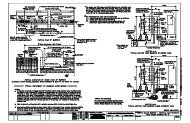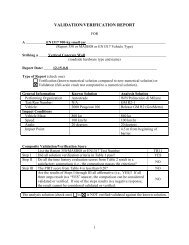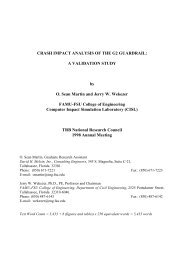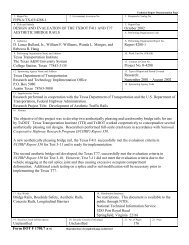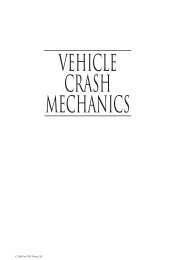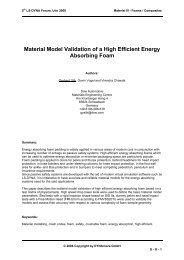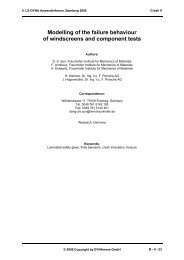Vehicle Crashworthiness and Occupant Protection - Chapter 3
Vehicle Crashworthiness and Occupant Protection - Chapter 3
Vehicle Crashworthiness and Occupant Protection - Chapter 3
Create successful ePaper yourself
Turn your PDF publications into a flip-book with our unique Google optimized e-Paper software.
Finite Element Analytical Techniques<br />
<strong>and</strong> Applications to Structural Design<br />
Belytschko <strong>and</strong> Tsay shell element is thus the sum of a plane stress membrane<br />
element <strong>and</strong> a Reissner-Mindlin plate element. Clearly, this is not valid if the<br />
element is warped. In a warped element, loads parallel to the local x-y plane cause<br />
bending strains <strong>and</strong> these strains are missed by the current element formulation.<br />
Consequently, warped Belytschko <strong>and</strong> Tsay elements severely underestimate<br />
the structure’s bending stiffness. This is why this element fails the twisted beam<br />
test often cited in the literature.<br />
In spite of a number of choices that clearly include a loss of generality <strong>and</strong><br />
tradeoff for numerical robustness <strong>and</strong> computational efficiency, the results<br />
obtained using the Belytschko <strong>and</strong> Tsay element in thous<strong>and</strong>s of crashworthiness<br />
simulations during more then a decade have been good enough to establish its<br />
usefulness to the industry. This can be explained in part by the particular nature<br />
of automotive crash events. Essentially, plastic hinges develop very rapidly over<br />
the full section of the thin (roughly 1 mm) sheet metal followed by large rigid body<br />
rotations of the parts between the hinges. Objectivity of the element is thus the<br />
primary requirement, <strong>and</strong> this is fulfilled in the element formulation. As long as<br />
the time for the development of the individual plastic hinges is small compared to<br />
the duration of the global event, the bending stiffness plays a less important role.<br />
Also, the small membrane deformation behavior <strong>and</strong> buckling behavior of the<br />
sheet metal is in line with the assumptions of the Belytschko <strong>and</strong> Tsay shell.<br />
Triangular elements were obtained by arbitrarily collapsing two nodes of a fournode<br />
shell element. This can result in a very inaccurate element, depending upon<br />
the shape of the triangle.<br />
3.2.4 Plasticity<br />
The plane stress plasticity at the individual integration points of the element is<br />
based on the membrane components of the stress tensor only. The yield condition<br />
is then written as follows for each integration point:<br />
σ<br />
2<br />
xx<br />
+ σ −σ<br />
σ +<br />
(3.2.4.1)<br />
2<br />
yy<br />
xx<br />
yy<br />
2 2<br />
3σ<br />
xy<br />
≤ σ<br />
y<br />
where the yield stress is a function of the equivalent plastic strain <strong>and</strong> the strain<br />
rate in one way or another. After performance of an elastic stress update the yield<br />
condition is checked, <strong>and</strong> if it is not fulfilled, the stresses must be scaled back to<br />
the yield surface. Here, care must be taken to account for the nature of the plastic<br />
deformation <strong>and</strong> thus a flow of the material at constant volume must be simulated.<br />
Usually, a Newton iteration technique involving the unknown through-thethickness<br />
strain in the element is performed. A non-iterative, radial return approach<br />
will lead to a deformation pattern involving a non-zero volumetric plastic strain.<br />
In fact, the apparent Poisson coefficient of the material during plastic deformation<br />
Page 123



